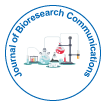Editorial
Redox Regulation in Animals to Slow Ageing
Biswaranjan Paital*Department of Zoology, CBSH, Orissa University of Agriculture and Technology, Bhubaneswar, India
- *Corresponding Author:
- Biswaranjan Paital
Department of Zoology, Orissa University of Agriculture and Technology
College of Basic Science and Humanities, Bhubaneswar
PIN- 751003, Odisha, India
Tel: +91-674-2397964
Fax: +91-674-2397780
E-mail: biswaranjanpaital@gmail.com
Received date: March 10, 2017; Accepted date: March 13, 2017; Published date: March 22, 2017
Citation: Paital B (2017) Redox Regulation in Animals for Slowing Ageing . J Biores Commun 1:e101.
Copyright: © 2017 Paital B. This is an open-access article distributed under the terms of the Creative Commons Attribution License, which permits unrestricted use, distribution, and reproduction in any medium, provided the original author and source are credited.
Abstract
Utilization of oxygen in varieties of biochemical reactions especially, in mitochondrial electron transport chain (ETC) to reduce O2 to H2O in aerobic organisms, lead to produce several active oxygen molecules. So, mainly ETC acts as the main hub in producing partially reduced O2, as several active oxygen species. These intermediate molecules are commonly known as reactive oxygen species (ROS; such as superoxide radical, hydroxyl radical and hydrogen peroxide). ROS being highly cytotoxic in nature produce deleterious effects on biomolecules. They can oxidize biomolecules non-specifically to produce lipid peroxides, protein carbonyls and nucleic acid adducts from lipids, proteins and nucleic acids, respectively [1].

 Spanish
Spanish  Chinese
Chinese  Russian
Russian  German
German  French
French  Japanese
Japanese  Portuguese
Portuguese  Hindi
Hindi